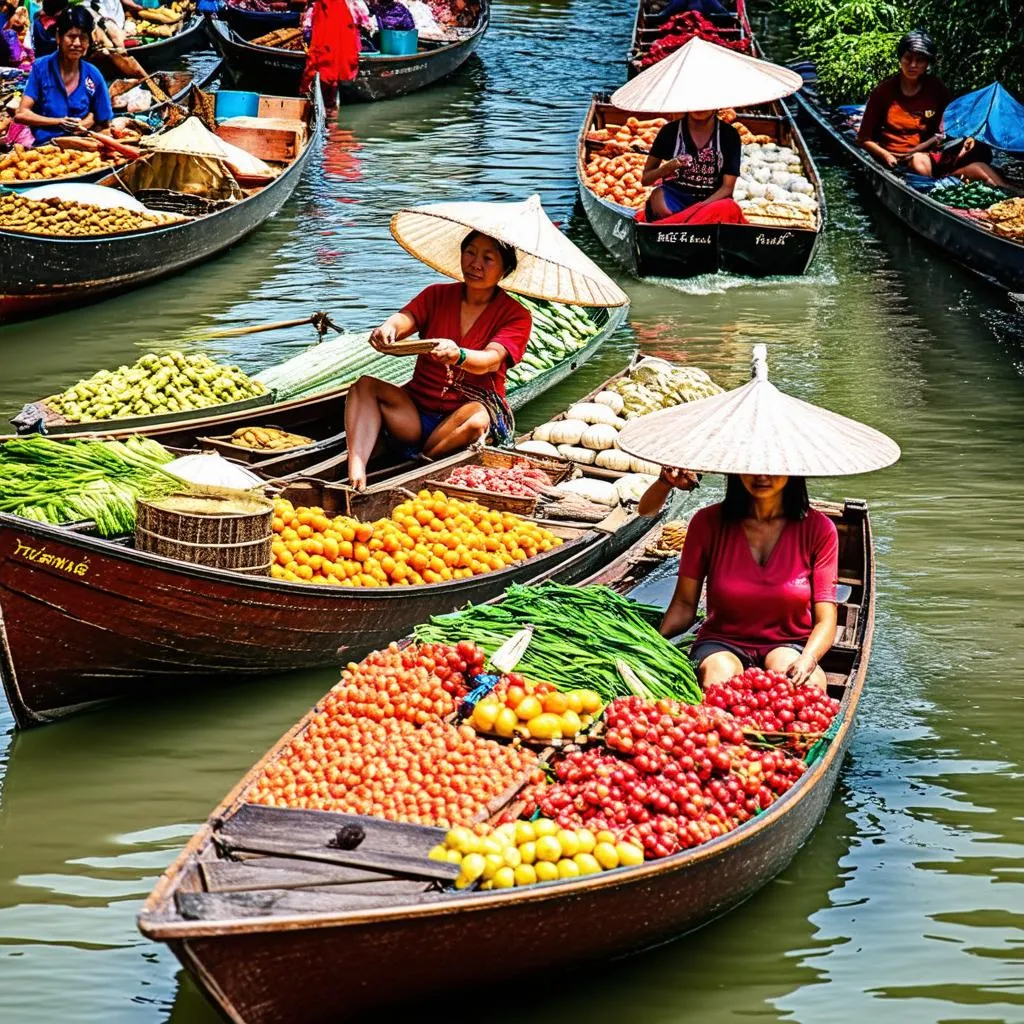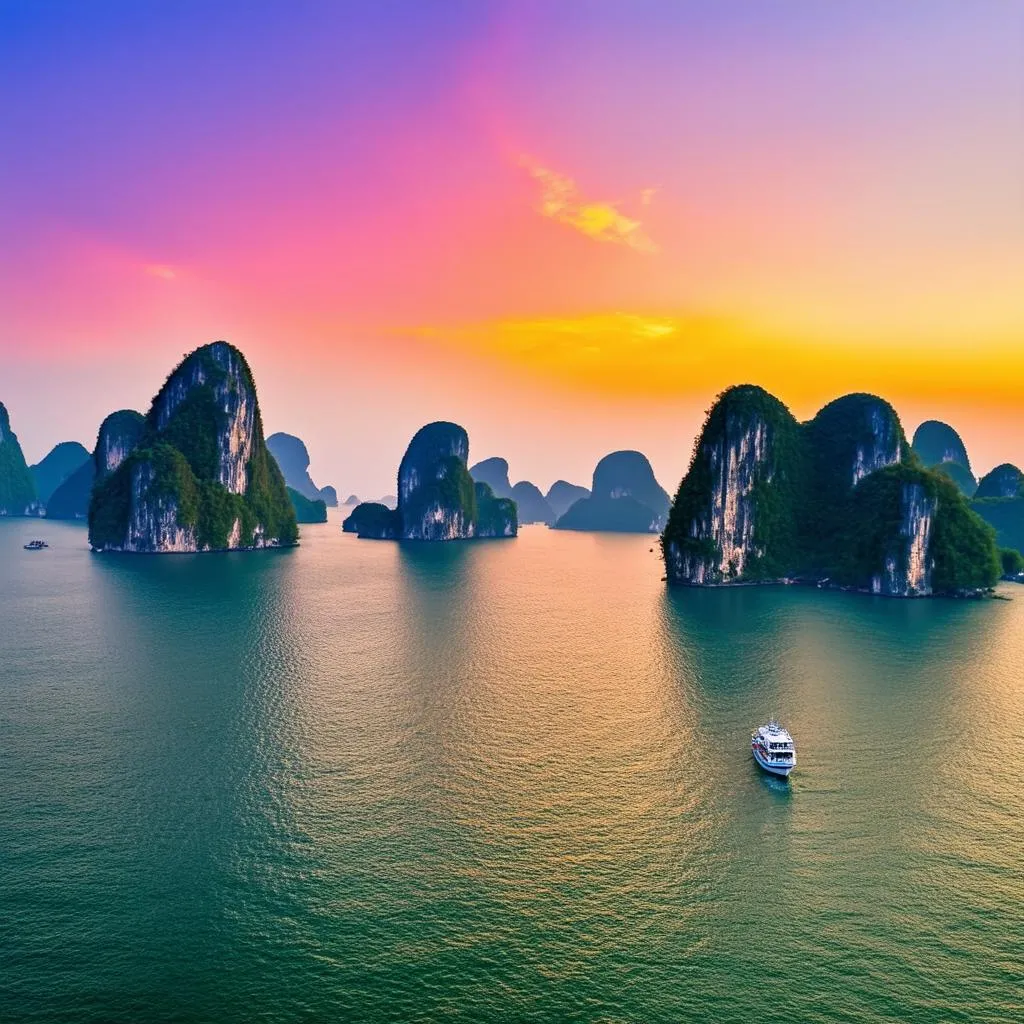“Đi một ngày đàng, học một sàng khôn” – a Vietnamese proverb that beautifully captures the essence of travel, translating to “A day of travel is a basket of wisdom.” And trust me, Vietnam overflows with baskets of wisdom, waiting to be discovered! From the emerald rice paddies of the Mekong Delta to the majestic mountains of Sapa, Vietnam is a tapestry woven with vibrant cultures, breathtaking landscapes, and warm hospitality.
Embark on a Journey Through Vietnam’s Tourist Regions
Choosing where to go in Vietnam can be a delightful dilemma. Do you crave the ancient charm of Hoi An, a UNESCO World Heritage Site, with its tailor shops and lantern-lit streets? Or perhaps the bustling energy of Ho Chi Minh City, where skyscrapers share the skyline with pagodas, calls to your adventurous spirit?
To help you navigate, we’ll delve into some of the most captivating tourist regions of Vietnam:
1. Northwest Vietnam: A Majestic Tapestry of Mountains and Cultures
Imagine trekking through valleys painted with rice terraces, the air crisp and cool, with towering mountains as your backdrop. This is Northwest Vietnam, a region where ethnic minority villages cling to hillsides, and ancient traditions thrive.
- Sapa: Famed for its dramatic rice terraces, Sapa offers breathtaking views and a chance to connect with local tribes like the Hmong and Dao.
- Ha Giang: Ride a motorbike along the legendary Ma Pi Leng Pass, winding through limestone peaks and deep valleys.
- Dien Bien Phu: This historic site marks a pivotal moment in Vietnamese history, where the Viet Minh army triumphed in 1954.
Expert Insight: “Northwest Vietnam is a feast for the senses,” shares travel writer, Nguyen Minh Anh, in his book “Wandering Souls: A Vietnamese Odyssey.” “The landscape is simply breathtaking, and the cultural experiences are unlike anywhere else in the world.”
2. Central Vietnam: Where History Meets Coastal Beauty
From imperial cities to pristine beaches, Central Vietnam is a captivating blend of cultural treasures and natural wonders.
- Hue: The former imperial capital, Hue, is a UNESCO World Heritage Site, home to majestic tombs, ancient temples, and the Perfume River.
- Hoi An: Step back in time in Hoi An, with its well-preserved merchant houses, tailor shops, and the iconic Japanese Covered Bridge.
- Da Nang: Relax on the golden sands of My Khe Beach, explore the Marble Mountains, or marvel at the Golden Bridge, held by giant stone hands.
Feng Shui Tip: Consider visiting the Thien Mu Pagoda in Hue, strategically located on the Perfume River. Pagodas are considered auspicious in Feng Shui, and the river’s flow enhances positive energy.
3. Southern Vietnam: The Heartbeat of the Mekong Delta
Southern Vietnam pulsates with life, from the bustling streets of Ho Chi Minh City to the tranquil waterways of the Mekong Delta.
- Ho Chi Minh City: Experience the energy of Vietnam’s largest city, with its French colonial architecture, vibrant markets, and delicious street food.
- Mekong Delta: Take a boat trip through the Mekong Delta, a labyrinth of rivers and canals, where life unfolds on the water. Visit floating markets, sample tropical fruits, and experience the unique culture of this fertile region.
- Phu Quoc Island: Escape to pristine beaches, turquoise waters, and lush rainforests on Phu Quoc Island, a tropical paradise off the coast of Cambodia.
Planning Tip: “When exploring the Mekong Delta,” advises veteran tour guide, Tran Thi Mai, “consider waking up early to experience the magic of the floating markets, where locals trade goods from their boats.”
 Vibrant Floating Market in the Mekong Delta
Vibrant Floating Market in the Mekong Delta
Crafting Your Unforgettable Vietnam Adventure
Planning Your Budget:
Vietnam offers incredible value for travelers, catering to a range of budgets:
- Budget travelers: Expect to spend around $20-30 per day, enjoying delicious street food, affordable accommodation, and local transportation.
- Mid-range travelers: Allocate $40-60 per day for more comfortable accommodation, restaurant meals, and domestic flights.
- Luxury travelers: For high-end resorts, fine dining experiences, and private tours, a budget of $100+ per day is recommended.
Essential Packing Tips:
- Light clothing: Vietnam’s tropical climate calls for lightweight, breathable clothing.
- Rain gear: Pack a light raincoat or umbrella, especially during the rainy season (May-October).
- Comfortable shoes: From trekking in Sapa to exploring ancient temples, comfortable shoes are a must.
- Mosquito repellent: Don’t let pesky mosquitos dampen your adventures!
Respecting Local Customs:
- Dress modestly: When visiting temples or pagodas, dress respectfully, covering your shoulders and knees.
- Ask permission: Always ask before taking photos of people, especially monks and nuns.
- Bargaining etiquette: Bargaining is common in markets, but be respectful and smile.
 Spectacular Sunset over Ha Long Bay
Spectacular Sunset over Ha Long Bay
Frequently Asked Questions about Traveling in Vietnam
1. What is the best time to visit Vietnam?
Vietnam offers year-round travel opportunities, but the best time to visit depends on your interests and the region you plan to explore.
- Spring (February-April): Pleasant temperatures, blooming flowers, and colorful festivals make it an ideal time to visit most of Vietnam.
- Autumn (September-November): Cooler temperatures and clear skies are perfect for trekking in the north and enjoying the beaches in the south.
- Summer (May-August): While hot and humid, summer offers vibrant festivals and lush landscapes.
- Winter (December-January): Expect cooler temperatures, especially in the north. It’s a good time to experience the rice harvest season.
2. Do I need a visa to visit Vietnam?
Citizens of many countries can enter Vietnam visa-free for a limited time. However, it’s essential to check the specific visa requirements based on your nationality before you travel.
3. How can I get around Vietnam?
Vietnam offers a variety of transportation options to suit different budgets:
- Flights: Domestic flights are convenient for traveling between major cities.
- Trains: Trains offer a scenic way to see the countryside, especially the Reunification Express, connecting Hanoi and Ho Chi Minh City.
- Buses: An affordable option for shorter distances, with both local and sleeper buses available.
- Motorbikes: Renting a motorbike is a popular way to explore Vietnam independently, especially in rural areas. However, it’s essential to have a valid international driver’s license and exercise caution.
4. Is it safe to travel in Vietnam?
Vietnam is generally a safe country for travelers. However, it’s always wise to exercise common sense, be mindful of your belongings, and avoid walking alone in secluded areas at night.
Travelcar.edu.vn: Your Gateway to Vietnam’s Wonders
Inspired to embark on your own Vietnamese adventure? Visit travelcar.edu.vn, your trusted travel companion, for insider tips, curated itineraries, and essential travel information.
Discover the magic of Vietnam with travelcar.edu.vn. Your journey of a lifetime awaits!